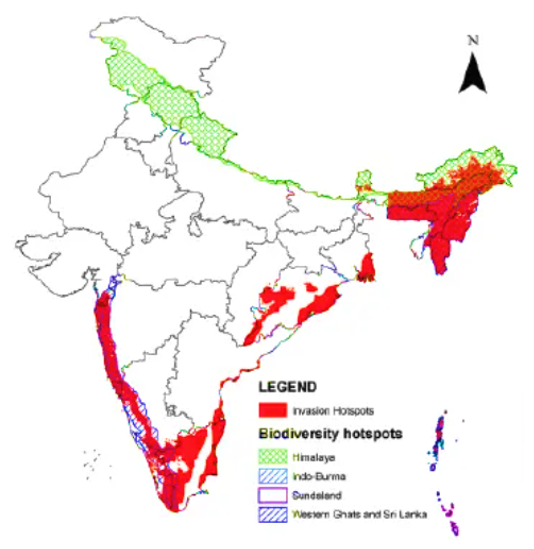Table of Contents
Biodiversity
Biodiversity, also known as biological diversity, refers to the variety and differences among all living things. All terrestrial (land-based), marine (aquatic), and other unique ecosystems and biological complexes are included. The term “biodiversity” refers to the richness and variety of life on earth. It is the most intricate and significant aspect of our world. Life could not persist without biodiversity. In 1985, the word “biodiversity” was first used.
Definition of Biodiversity as per CBD
The Convention on Biological Diversity (CBD) defines biodiversity as, “the variability among living organisms from all sources including terrestrial, marine & other aquatic ecosystems, and the ecological complexes of which they are part, this includes diversity within species, between species & of ecosystems.”
Types of Biodiversity
Biodiversity is the multitude of genes, species, communities and ecosystems. recognized at the three levels; i.e., genetic diversity, species diversity & ecosystem diversity.
Ecological diversity
An ecosystem is a collection of living and non-living organisms and their interaction with each other. Ecological biodiversity refers to the variations in the plant and animal species living together and connected by food chains and food webs. It is the diversity that is present between the ecosystems in a region. For e.g. variety of ecosystems like wetlands, corals, estuaries, deserts, mangroves, temperate forests & so on.
Genetic diversity
A single species’ gene pool contains a wide range of genes. The term “gene pool” refers to the total number of genes in a species. Genetic diversity refers to the variation of genes within a species’ gene pool. As every individual of a particular species differs from each other in their genetic constitution due to which every human looks different from each other. In the same manner there are different varieties in the same species of rice, wheat, maize, barley, etc.
Species diversity
It is the diversity of species found on Earth in various habitats. For instance, tropical rainforests are home to a wide range of species of plants, animals, and microbes. It is to be noted that no two individuals of the same species are exactly similar. For example, humans show a lot of diversity among themselves.
Measurement of Biodiversity
Diverse impartial techniques have been developed by conservation biologists to empirically measure biodiversity. Each indicator of biodiversity corresponds to a specific application of the information. Measurements should take into account a quantification of values that are typically shared by locally impacted creatures, such as people. However, for an assessment of biodiversity, the following parameters need to be evaluated:
- Species number : It is also referred as Species richness which measures the number of species found in per unit area of a region or community. It has three components as:
- Alpha diversity: refers to the diversity of the species that are found in a particular region or an ecosystem, and is usually expressed by the number of species in that particular ecosystem such as a pond, a field, or a patch of forest.
- Beta diversity: refers to the comparison of the diversity of species between two or more ecosystems, usually measured as the change in the number of species between the ecosystems.
- Gamma diversity: It is the measure of the overall diversity for the different ecosystems in a region. It is highly subjective because of different perceptions about the boundaries of the region.
- Species evenness: It is the measure of relative abundance of individuals of different species in a given region. Low evenness in general, means that a few species dominate the region or ecosystem.
Biodiversity Hotspots
Biodiversity hotspots are areas with high levels of species diversity, a large number of endemic species (species that are unique to a particular region), and a sizable number of threatened or endangered species. The term Biological Hotspots has been coined by Norman Myers. According to Conservation International, a region must fulfill the following two criteria for qualifying to be considered as Biological hotspot:
- The region should have at least 1500 species of vascular plants i.e., it should have a high degree of endemism.
- It must contain 30% (or less) of its original habitat, i.e. it must be threatened.
Biodiversity Hotspots in India
India is particularly known for its richness in biodiversity and it has around 24.46% of the geographical area covered by forests and trees. Four of the worlds 36 biological hotspot are being found in India that fulfills the criteria for qualifying to be considered as Biological hotspot:
- The Himalayas
- Indo-Burma Region
- The Western Ghats
- Sundaland

Loss of Biodiversity
A loss of biodiversity is the disappearance of species, ecosystems, or genetic resources. The planet’s biological diversity is dwindling quickly. 784 species, comprising 338 vertebrates, 359 invertebrates, and 87 plants, have perished in the previous 500 years, according to the IUCN Red List. More than 30 species have disappeared in the last 20 years alone. According to a report by Living Planet:
- The current rate of species extinction is between 100 and 1000 species every 10,000 species during a period of 100 years. This exceeds the natural rate of extinction by over 1000 times.
- The amount of biodiversity abundance as measured by the living planet index is consistently declining. Since 1970, the population of observed species has decreased by 58% on average.
- Since 1970, there has been a 40% drop in the number of species in tropical forests.
- While species populations have decreased by 81% in freshwater environment and 18% in temperate grasslands, respectively, since 1970.
Causes of the Loss of Biodiversity
The loss of biological diversity is caused by both the global extinction of many species and the local decline or extinction of species in a particular region. Depending on whether the environmental deterioration that causes the loss is practically permanent (for example, through land loss) or reversible through ecological restoration or ecological resilience, the latter phenomenon can be either temporary or permanent. Human actions that go beyond the bounds of the earth are causing the current global extinction, also known as the sixth mass extinction or the Anthropocene extinction, which has so far been proven irreversible. The causes of Loss of Biodiversity are:
- Habitat loss and fragmentation: This is the main factor responsible for the extinction of both animals and plants. Through land use changes, specifically the conversion of natural ecosystems to farmland, the construction of infrastructure projects like trains and motorways, growing urbanization, and mining activities, habitat loss and fragmentation have occurred.According to the Living Planet research, wetlands have decreased by around 30% over the past 40 years. The primary uses of restored wetlands are for agriculture and urban development.
- Additionally, around 45% of the temperate grasslands and 50% of the tropical and subtropical forests have been altered for human use. Along with total loss, pollution-induced habitat degradation puts many species’ survival at risk. when expansive environments are divided into tiny pieces as a result of various human activities.
- Over-exploitation of species: One of the main causes of biodiversity loss is the unsustainable use of ecosystems and the overexploitation of species. Overfishing, overhunting, and overharvesting of plant products can all fast cause biodiversity to disappear. It is sometimes stated that the main cause of this unsustainable exploitation of natural resources is changing human consumption patterns. Many animals that became extinct in the last five centuries, such the passenger pigeon and Steller’s sea cow, were over-exploited by human.
- Introduction of alien species: Because they compete with native species for food and shelter, spread diseases that are unfamiliar to them, interbreed with native species, and disrupt various aspects of their food chains and physical environment, plants, animals, and microorganisms that are intentionally or unintentionally transported from outside geographic regions can do significant harm to native species. For instance, the British brought the water hyacinth to India as a means of beautifying. But over time, it developed into an invasive species that clogs rivers, lakes, and other bodies of water, preventing the growth and survival of any aquatic life.
- Environmental pollution: The buildup of pollutants, such as phosphorus and nitrogen, that are released into natural water bodies, including hazardous substances from urban and suburban runoff, industrial effluents, etc. Consider the 2017 oil leak off the Chennai port of Ennore. Animals also perish as a result of plastic pollution. Moreover, automobile and industrial air pollution has resulted in the death of many bird species in urban areas.
- Global climate change: In the years to come, climate change is predicted to pose an increasingly serious danger to biodiversity. It has already been noted that different species’ distributions and flowering and migration patterns are changing all throughout the world. In environments where various species have evolved synchronized interdependence, these alterations have disrupted food chains and produced mismatches.
- Co-extinctions: The plants and animals that are inextricably linked to a particular species when it goes extinct also run the risk of going extinct. For instance, when a host fish species goes extinct, its particular collection of parasites also perishes.
- Natural causes: Causes such as earthquakes, floods, volcanic eruption, forest fire and other natural disasters also cause loss of biodiversity.
Conservation of Biodiversity
Conservation of biodiversity is protection, upliftment and scientific management of biodiversity so as to maintain it at its threshold level and derive sustainable benefits for the present and future generation. The conservation of biodiversity is important because it helps to maintain the natural balance of the environment, and it also provides a variety of economic and social benefits. There are three major objectives of Biodiversity conservation:
- Sustainable utilization of species and ecosystem.
- Preservation of the diversity of species.
- Maintaining the life-supporting systems and essential ecological processes.
Biodiversity Conservation Methods
Two types of methods are employed to conserve biodiversity. They are- In situ conservation and Ex-situ conservation.
- In-Situ: The maintenance and defense of the species in their natural habitat is referred to as in situ conservation. In natural populations of plant or animal species, it refers to the preservation of genetic resources. Managing biodiversity in its natural habitat is referred to as in situ conservation. The benefits of in-situ conservation are as follows:
- National parks and sanctuaries
- Biosphere reserves
- Nature reserves
- Reserved and protected forests
- Preservation plots
- Reserved forests
- Ex-Situ: Breeding and maintaining endangered species in man-made habitats like zoos, nurseries, botanical gardens, gene banks, etc. is known as ex-situ conservation of biodiversity. Less organisms are competing with one another for food, water, and available space. Ex situ conservation is the preservation of biodiversity away from their natural habitats. Here, zoological or botanical parks are places where animals and plants are raised or grown.
- Another method of ex situ conservation is the reintroduction of an animal or plant into its former environment. For instance, the Gangetic gharial, which had gone extinct in the rivers of Uttar Pradesh, Madhya Pradesh, and Rajasthan, has been reintroduced.
- Seedbanks, botanical, horticultural and recreational gardens are some of the examples of ex situ conservation.
International Efforts on Conservation of Biodiversity
The International Efforts on Conservation of Biodiversity have been discussed below:
- Ramsar Convention on Wetlands
- Convention on Biological Diversity, 1992 (CBD)
- Convention on International Trade in Endangered Species of Wild Fauna and Flora (CITES)
- Convention on the Conservation of Migratory Species of Wild Animals (CMS)
- Minamata Convention on Mercury
- Stockholm Convention on Persistent Organic Pollutants


 National Technology Readiness Assessment...
National Technology Readiness Assessment...
 Justice Mission-2025: China’s Live-Fir...
Justice Mission-2025: China’s Live-Fir...
 Suryastra: First Made-in-India Long-Rang...
Suryastra: First Made-in-India Long-Rang...

























